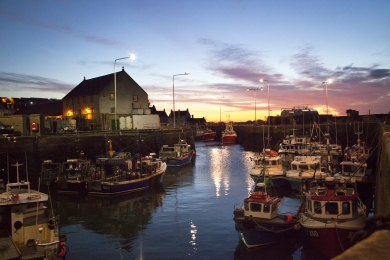
Dawn in Pittenweem harbour in October 2011.
Dawn in Pittenweem harbour, Scotland, October 2011.
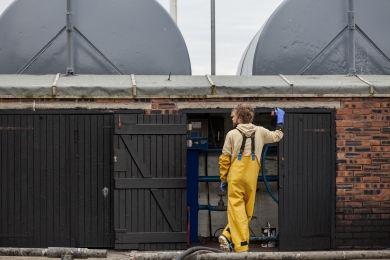
FRoyer_GB_20150618_7496
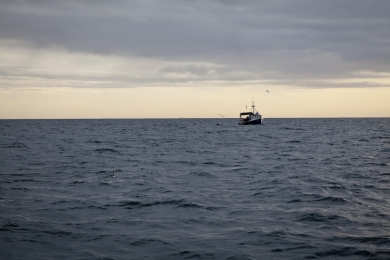
Losbter boat in the Firth of Forth in the early morning in October 2011.
Losbter boat in the Firth of Forth in the early morning, Scoltand, October 2011.
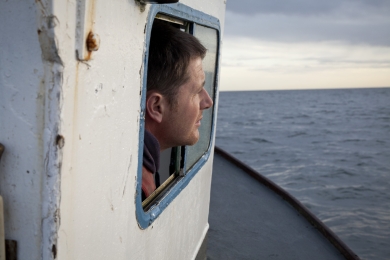
Richard Scott on board of his lobster boat 'Fiona S' looks by the cabin window while on his way to haul his creels in the Firth of Forth in Scotland in Ocotber 2011.
Richard Scott on board of his lobster boat 'Fiona S' looks by the cabin window while on his way to haul his creels in the Firth of Forth, Scotland, Ocotber 2011.
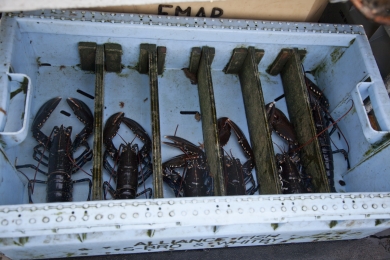
FRoyer_20111011_GB_9513
Lobsters are kept separately to avoid them fighting with each other and losing a claw. Scotland, October 2011.
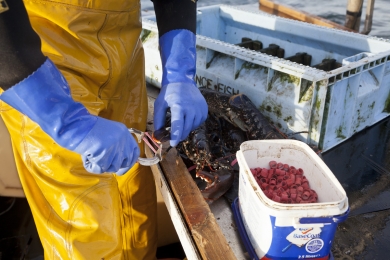
Richard scott slips rubber bands over lobsters' claws while on board of his lobster boat in the Firth of Forth in Scotland in Ocotber 2011.
Richard Scott slips rubber bands over lobsters' claws while on board of his lobster boat in the Firth of Forth, Scotland, Ocotber 2011.
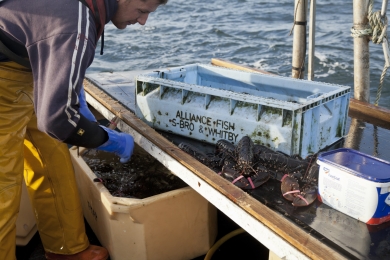
Richard Scott keeps the lobsters in a water tank after catching them on board of his lobster boat Fiona S in the Firth of Forth in Scotland in October 2011.
Richard Scott keeps the lobsters in a water tank on board of his lobster boat Fiona S in the Firth of Forth, Scotland, October 2011.
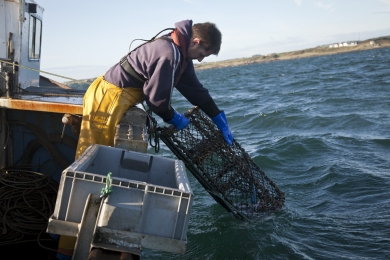
Richard Scott hauls a creel that wrapped itself round his own creels on bvoard of his lobster boat 'Fiona S' in the Firth of Forth in Scotland in October 2011.
Richard Scott hauls a creel that wrapped itself round other creels in the Firth of Forth, Scotland, October 2011.
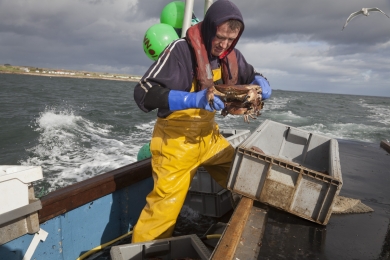
Richard Scott is keeping brown crabs on a bumpy sea before heading back to Pittenweem harbour, October 2011.
Richard Scott is keeping brown crabs in boxes before heading back to Pittenweem harbour on a bumpy sea, Scotland, October 2011.
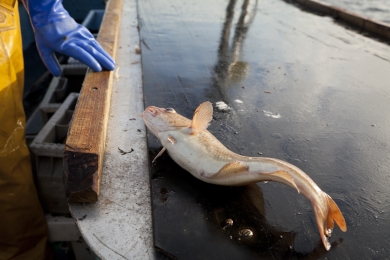
Richard Scott caught a fish in one of his creels in the Firth of Forth in Scotland in October 2011.
Richard Scott caught a fish in one of his creels. Fish are scarce nowadays in the Firth of Forth, Scotland, October 2011.

FRoyer_20111012_GB_9890
Pittenweem harbour used to be very lively, white fish was auctioned every morning and there was enough fish to cover the whole harbour pier. Photograph from the late 1940s (?). Scotland.

Richard Scott in the wheelhouse before entering in Pittenweem harbour in Scotland in October 2011.
Richard Scott in the wheelhouse before entering in Pittenweem harbour, Scotland, October 2011.
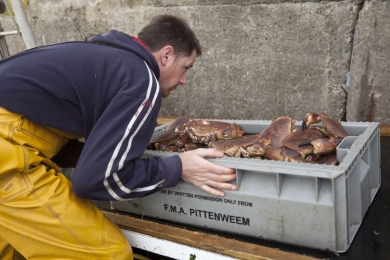
Richard Scott is unloading his catch of the day that consists of brown crabs, velvet crabs and lobsters in Pittenweem harbour in Scotland in Ocotber 2011.
Richard Scott is unloading his catch of the day that consists of brown crabs and lobsters in Pittenweem harbour, Scotland, October 2011.
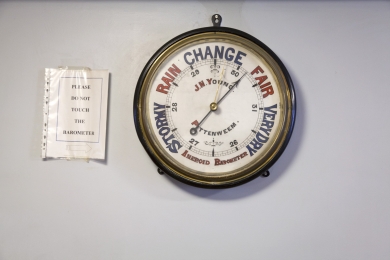
Pittenweem harbour barometer.
Pittenweem harbour barometer in Pittenweem harbour master building, Scotland, October 2011.
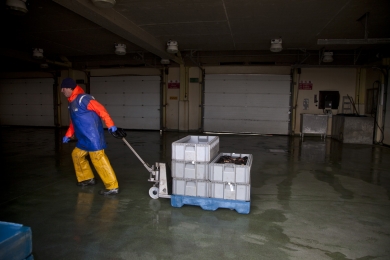
Carrying the catch of the day in Pittenweem fishmarket, October 2011.
Carrying the catch of the day in Pittenweem fish market, Scotland, October 2011.

Richard Hogg and Stuart are keeping velvet crabs in boxes in Pittenweem fish market for transportation, October 2011.
Richard Hogg and Stuart are keeping velvet crabs in boxes in Pittenweem fish market, Scotland, October 2011.

FRoyer_20111012_GB_9518
Lobsters have to be weighted then packed for transportation. Pittenweem fish market, Scotland, October 2011.

Richard, Euan and Stuart are packing lobsters in polyester boxes for transportation in Pittenweem fishmarket in Scotland in October 2011.
Euan Loggans is packing lobsters in polyester boxes for transportation in Pittenweem fish market, Scotland, October 2011. The lobsters will end up in French supermarkets, in Spain and/or even Italy.
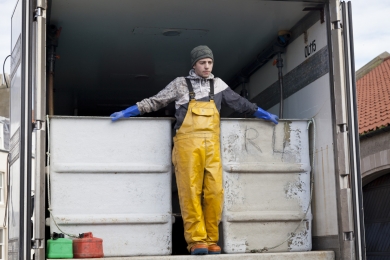
Stuart Loggans is about to load the lobsters in the truck's water tanks in Pittenweem fishmarket in Scotland in October 2011.
Stuart Loggans is about to load the lobsters in the truck's water tanks in Pittenweem fish market, Scotland, October 2011.

Fishermen unload the catch of the day in Pittenweem fish market in Scotland in October 2011.
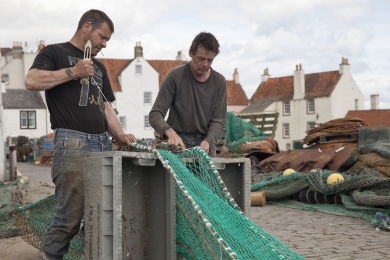
FRoyer_20140619_GB_2631
Fishermen mend their net in Pittenweem harbour, Scotland, July 2014.
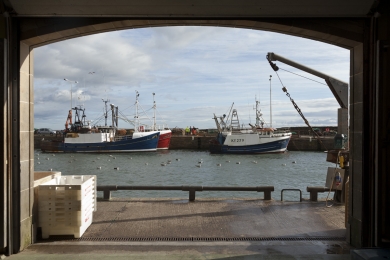
Harbour from inside the fish market in Pittenweem in Scotland in Ocotber 2011.
Pittenweem harbour from inside the fish market. There used to be many more fishing boats and larger ones too in the harbours up to the early 80's, e.i. at the height of the fishing industry. Locals still remember the days when one could walk on the decks of the boats from one side of the harbour to the other. Scotland, Ocotber 2011.
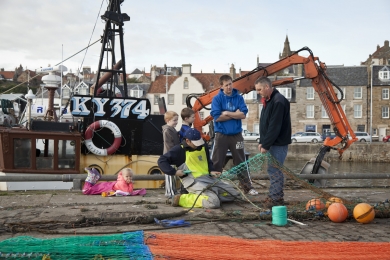
Mending the net i Pittenweem harbour.
William Wood and his father Jim are mending their net in Pittenweem harbour, Scotland, October 2011.
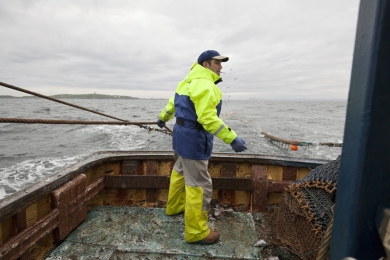
William Wood, who has been a fishermen for over 10 years, is shooting the net on the Launch Out off the isle of May in Scotland, October 2011.
William Wood, who has been a fishermen for over 10 years, is shooting the net on the Launch Out off the isle of May, Scotland, October 2011.
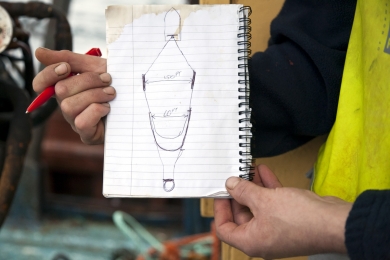
William Wood draw a picture of the net under water and the trawler.
William Wood draws a picture of the net under water, the trawler boards and the trawler in front to show how the langoustines are caught, Scotland, October 2011.
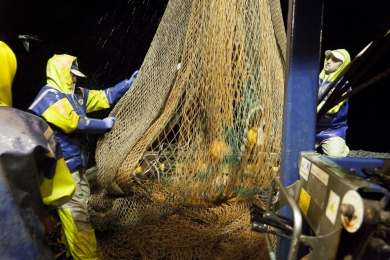
William and James Wood are hauling the net on the Launch Out in the middle of the night in Scotland in Ocotber 2011.
William and James Wood are hauling the net on the Launch Out in the middle of the night. They go at sea late afternoon and come back early morning in the winter season. Scotland, October 2011.
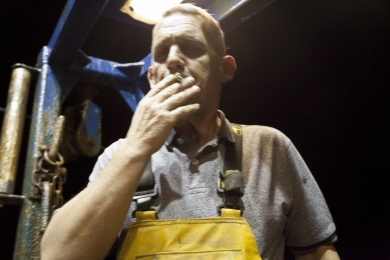
Jim Wood, the skipper, smokes a cigarette at the stern of the Launch Out in the evening in October 2011 after hauling the net.
Jim Wood, the skipper, smokes a cigarette at the stern of the Launch Out in the night, Scotland, October 2011.
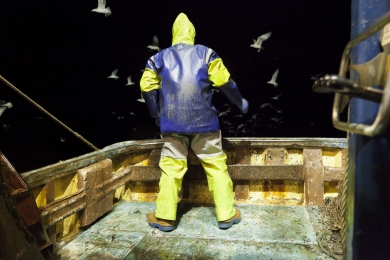
William Wood at the stern of the Launch Out after shooting the net in the middle of the night in Scotland in Ocotber 2011.
William Wood at the stern of the Launch Out after shooting the net in the middle of the night, Scotland, Ocotber 2011.

Seagulls are following the trawler 'Launch Out' that is fishing for shellfishes at night near the Firth of Forth in Scotland in October 2011.
Seagulls are following the 50 feet trawler 'Launch Out' that is fishing for shellfishes at night in the Firth of Forth, Scotland, October 2011.
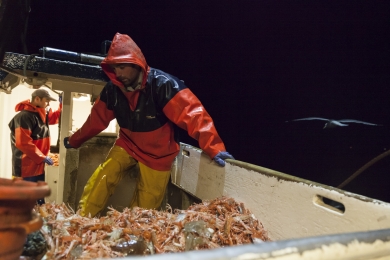
FRoyer_GB_20150624_8588
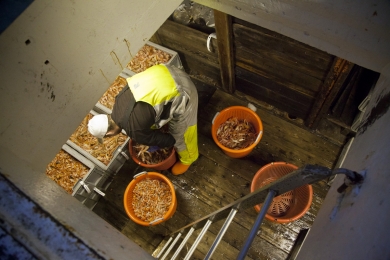
James Wood keeps the prawns and langoustines caught during the night with the trawler Launch Out in Scotland in October 2011.
James Wood keeps the prawns and langoustines caught during the night on board of the trawler 'Launch Out', Scotland, October 2011.

froyer_gb_20120731_7286
Ali rolls a cigarette before hauling the net on board of the trawler 'Launch Out', Scotland, July 2012.

froyer_gb_20120731_6797
Hauling the next on board of the 'Launch Out' early morning in the Firth of Forth, Scotland, July 2012.
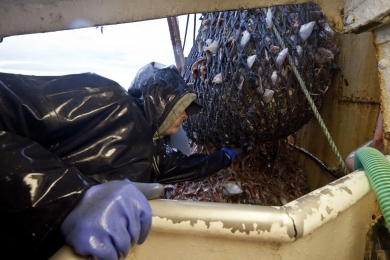
froyer_gb_20120731_6828
Ali opens the cod end of the net full of prawns and langoustines on board of the trawler 'Launch Out', Scotland, July 2012.

froyer_gb_20120731_5980
Bits and pieces of langoustines at the stern of the trawler 'Launch Out', August 2012.
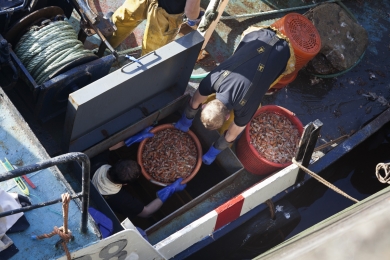
froyer_20120803_gb_8068
Landing the prawns in Pittenweem fish market, Scotland, August 2012.

froyer_gb_20120731_7484
Jim Wood sorts out the prawns at the stern of his trawler 'Launch Out' in the Firth of Forth, Scotland, July 2012.
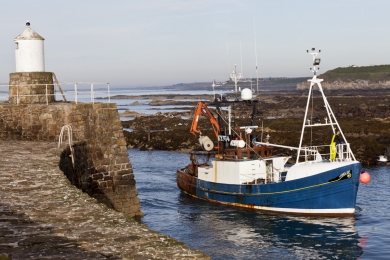
Launch Out trawler coming back to Pittenweem harbour early morning in July 2013.
The trawler 'Launch Out' comes back to Pittenweem harbour early morning, Scotland, July 2013.
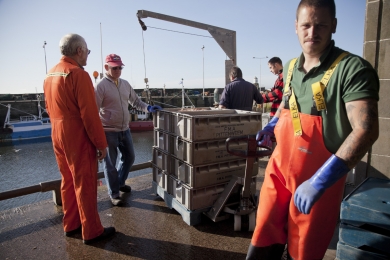
froyer_gb_20120731_5611
Landing the prawns in Pittenweem fish market, Scotland, August 2012.

FRoyer_GB_20130807_7163
Nowadays, trawlers do not land more than a box of fish each per day. They mainly catch flat fish and monkfish. Pittenweem fish market, Scotland, August 2013.
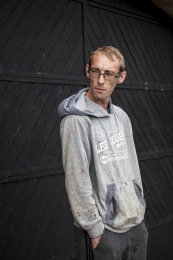
FRoyer_GB_20150622_8126
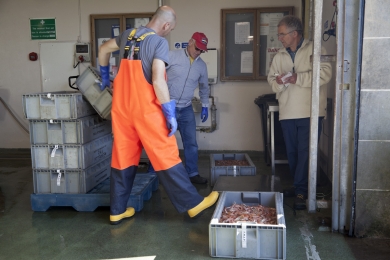
froyer_gb_20120731_5752
Billy Hughes from the FMA (Fishermen's Mutual Association) weights the langoustines in Pittenweem fish market as soon as the fishermen land them in the market, Scotland, August 2012.
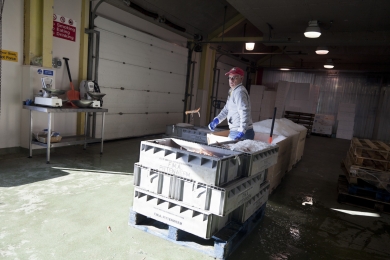
froyer_gb_20120731_5584
Covering the prawns and langoustines with ice before transportation, Pittenweem fish market, Scotland, August 2012.
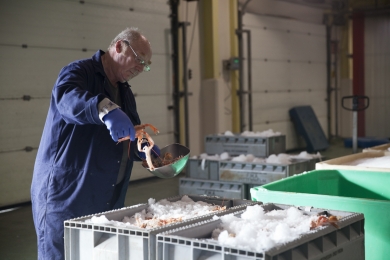
FRoyer_GB_20130807_7135
Peem, who used to be a fishermen, works some days in Pittenweem fish market where he packs the prawns with ice, ready for transportation. Scotland, August 2013.

FRoyer_20120803_GB_7842
Fishermen blue gloves in Pittenweem harbour with Sun newspaper, Scotland, August 2012.
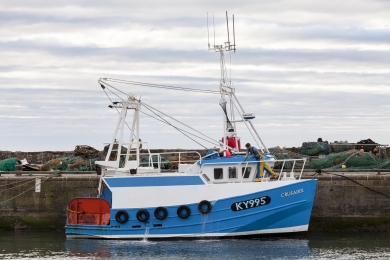
Fisherman on trawlwer Crusader cleans the boat after landing his catch in Pittenweem harbour, early morning, June 2015.